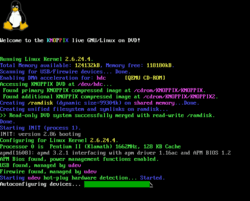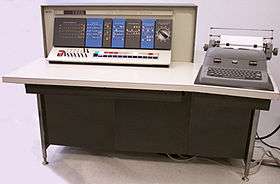System console

The system console, computer console, root console, operator's console, or simply console is the text entry and display device for system administration messages, particularly those from the BIOS or boot loader, the kernel, from the init system and from the system logger. It is a physical device consisting of a keyboard and a screen, and traditionally is a text terminal, but may also be a graphical terminal. System consoles are generalized to computer terminals, which are abstracted respectively by virtual consoles and terminal emulators. Today communication with system consoles is generally done abstractly, via the standard streams (stdin, stdout, and stderr), but there may be system-specific interfaces, for example those used by the system kernel.
History

Prior to the development of alphanumeric CRT system consoles, some computers such as the IBM 1620 had console typewriters and front panels while the very first programmable computer, the Manchester SSEM, used a combination of electromechanical switches and a CRT to provide console functions—the CRT displaying memory contents in binary by mirroring the machine's Williams-Kilburn tube CRT-based RAM.
On traditional minicomputers, the console was a serial console, an RS-232 serial link to a terminal such as a DEC VT100. This terminal was usually kept in a secured room since it could be used for certain privileged functions such as halting the system or selecting which media to boot from. Large midrange systems, e.g. those from Sun Microsystems, Hewlett-Packard and IBM, still use serial consoles. In larger installations, the console ports are attached to multiplexers or network-connected multiport serial servers that let an operator connect a terminal to any of the attached servers. Today, serial consoles are often used for accessing headless systems, usually with a terminal emulator running on a laptop. Also, routers, enterprise network switches and other telecommunication equipment have RS-232 serial console ports.
On PCs and workstations, the computer's attached keyboard and monitor have the equivalent function. Since the monitor cable carries video signals, it cannot be extended very far. Often, installations with many servers therefore use keyboard/video multiplexers (KVM switches) and possibly video amplifiers to centralize console access. In recent years, KVM/IP devices have become available that allow a remote computer to view the video output and send keyboard input via any TCP/IP network and therefore the Internet.
Some PC BIOSes, especially in servers, also support serial consoles, giving access to the BIOS through a serial port so that the simpler and cheaper serial console infrastructure can be used. Even where BIOS support is lacking, some operating systems, e.g. FreeBSD and Linux, can be configured for serial console operation either during bootup, or after startup.
It is usually possible to log in from the console. Depending on configuration, the operating system may treat a login session from the console as being more trustworthy than a login session from other sources.
See also
- Command-line interface (CLI)
- Console application
- Console server
- Linux console
- Virtual console
- Win32 console